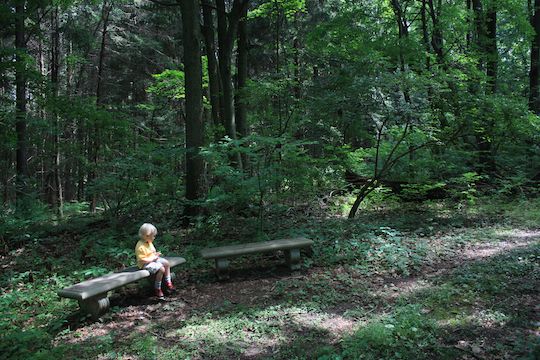Crow’s Nest: Visiting other preserves
Owen and I have now visited 14 of the 16 preserves listed in the Field Guide to Natural Lands Trust Preserves. This weekend we visited Gwynedd Preserve and Mariton Wildlife Sanctuary. It was a bit of a shock to find Tim at work in his office on a beautiful Saturday afternoon, but he was compiling the butterfly survey stats from that morning’s walk. We explored his visitor center with its animal mounts, bones, tracks, nests and pelts.
Our preserves span the continuum of states of succession of natural areas in our region. Both Gywnedd and Mariton contain lands that were formerly farmed, but Gywnedd’s fields were farmed more recently and most of it is managed as an early successional grassland, good habitat for grassland-nesting birds. Step down the path at Mariton and you find yourself suddenly in mid-successional woods that look like they’ve been there much longer than they have (about 100 years). Interpretive signs there inform you about the age of each section of woods, ranging from a sassafras thicket that was meadow a decade ago to 50, 100, and greater ages. As forests age, their structure usually diversifies—they become stands of more uneven age. And their species composition changes to trees that are more shade tolerant—at least until the next disturbance.
Natural Lands Trust Preserves are diverse, representative of different habitats and, I might add, a great place to get away to on a summer’s afternoon. They are quiet places away from the crowds.
Being there as a visitor is a different experience for me. I usually arrive at another preserve first thing in the morning of a workday after having fought rush-hour traffic (something I don’t contend with on the 100-foot walk from house to barn at Crow’s Nest) and get briefed over coffee about the day’s work. This weekend I had nowhere I needed to be and nothing to do but spend the day with Owen (now almost 3).
Owen walked some of the trails, got carried some, picked up and threw twigs, screamed at a wriggly worm and then gave it a welcoming “hi” when I held it for him and then blew it a kiss. We saw an indigo bunting, a fritillary, and lots of milkweed in flower. Mariton appears to be a little ahead of us in this latter species’ blooming.

